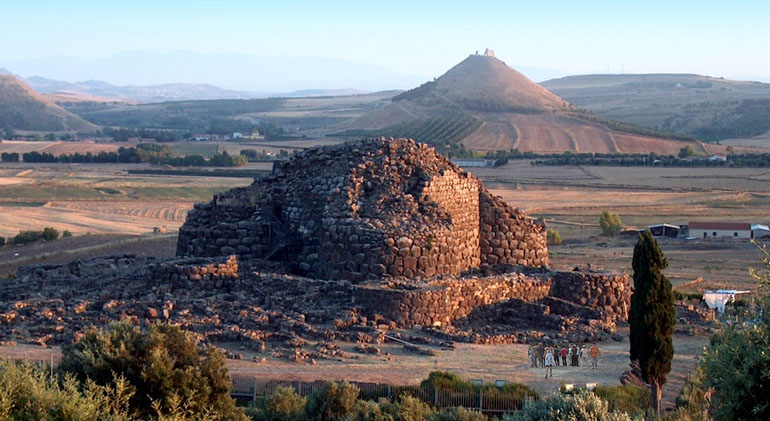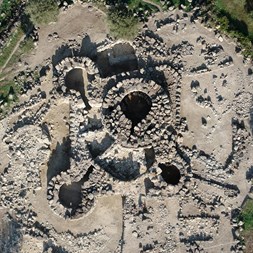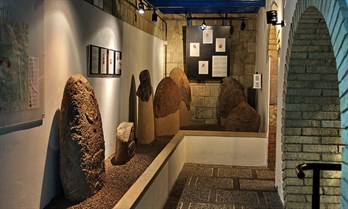The Marmilla
The LAG Marmilla territory is composed of 44 neighbouring Municipalities, straddling the provinces of Oristano and of the Middle Campidano.
It is an internal area territory, with prevailing rural characteristics, sporadic anthropic settlement, valuable environmental resources, material (mostly internationally outstanding archaeological) and immaterial cultural resources. The landscape has been outlined by pastoral farming and cereal-growing cultivations.

Agriculture still represents a relevant sector for the economy of the territory. The main production activities are: cereal-growing, olive growing, ovine and goat herding. Agricultural and food industry is distinguished by a great potential for development, although their organizational level is insufficient. There are valuable projects in the following sectors: agricultural and food, artistic, typical and traditional handicraft, textile manufacturing, iron and wood work.
The cultural resources of this territory are a real point of strength. There are various available archaeological sites, museums, country parks, ancient churches, traditional houses and houses which have become museums, alongside a rich heritage of demo- anthropological culture. In this framework, there are important traditional events linked to popular culture and others connected to cultural interchange. There is a close network of small well-preserved historic centres.
The territory has important natural elements of great value, with two natural protected areas. The importance of places which are attractive by an archaeological point of view, such as the nuraghic village of “Su Nuraxi” (UNESCO heritage) located in Barumini, or a naturalistic and environmental point of view, such as the Giara of Gesturi and Mount Arci, as well as other high-level attractions that mark a scattered touristic offering is to be stressed.
Accommodation capacity is mainly structured on scattered hospitality, such as B&B and holiday farms. In the last years the area has already been a target of the Leader II as well as the Leader + program.
The Marmilla LAG area is united by the presence of a rich cultural heritage, which begins with much archaeological evidence, sign of prehistoric man presence and of the course of history, passes through popular culture in the deep features of its rural area, finds its full expression in the diversity of architectural styles, in typical products flavours, in the traditional expressions set, and in general in the rural landscape of Marmilla. All that constitutes a potential and priceless cultural system to be made the most of.
Within the territory there are many archaeological riches of notable interest, representative of cultural processes which swept across Sardinia, as from the pre-nuraghic age, with Neolithic and Chalcolithic, till the Nuraghic age:
- “Su Nuraxi” of Barumini (UNESCO World Heritage) is undoubtedly the most valuable and well-known site of the territory.
- Is Cirquittuscromlech of Laconi;
- the Valley of the menhirs of Sant’Antonio, where the Cuccuru Tundu menhir (nearly six metres high) lops and various menhirs are deployed in the whole area (Morgongiori, Asuni, Nureci, Senis, Pompu, etc.).
- the domus de janas hypogean sepulchres are important signs of prehistoric man sacredness and point to the strong yoke he sealed with Mother Earth (Genna Salixi, Serra Longa - Villa Sant’Antonio; Bigia ‘e Monti- Gonnostramatza; etc.).
- the big number of extraction pits and lithic first working shops Mount Arci’s versants are scattered with, witness the flourishing market connected to obsidian (priceless volcanic ore called “aurum nigrum”) ancient mining, which started 8.000 years ago and supplied the entire Sardinian territory, Corsica, North Italy, Provence and Catalonia. That market played a vital role in the economy of ancient Sardinia.
- anthropomorphous statuary of Laconi
- Sardinia autochthonous (nuraghic) culture symbols find expression in great numbers of nuraghs and villages (Pinna ‘e Maiolu village; Genna Maria - Villanovaforru nuraghic group, located in the homonymous Archaeological Park; Cuccurada - Mogoro, S. Miali - Pompu; Bruncu ‘e S’Omu – Villa Verde; Pitzu Cummu - Lunamatrona; Su Mulinu - Villanovafranca; Bau Pendula - Mogorella; and many others), in the water cult hypogean temples(Saint Salvatore’s sanctuary - Gonnosnò; Scaba ‘e Cresia, Sa Grutta ‘e Is Caombus - Morgongiori), in the Giants Tombs (Sa domu ‘e S’Orcu - Siddi; Su Lacu de su Meli - Pompu; Sas Lappideddas - Gonnosnò; Cuaddu ‘e Nixias - Lunamatrona).
- the remains of Iulia Augusta Uselis Roman colony, which go back to the historical epoch, evidence Punic and Roman presence. It was a military outpost which served the function of overseeing ways of communication towards Sarcidano and Barbagias.
- The remains of the castle located inside Aymerich Park of Laconi go back to the Middle Ages. Tradition has it that the castle was a place of amusement of the “judicissa” (female judge) Eleanor of Arborea.
Regarding cultural heritage management activities, Sa Corona Arrubia Touristic Consortium, which promotes a cultural, environmental and accommodation touristic system, represents a proven model and a symbolic development sample.
The Consortium manages various museums: Museum of the Territory; Naturalistic Museum “Sa corona Arrubia”; “Genna Maria” Archaeological Museum of Villanovaforru; “Su Mulinu” Archaeological Museum of Villanovafranca; The Museum of barbaresques incursions in Sardegna, named “Turcus e Morus”, in Gonnostramatza; “Casa Steri” Museum of Sardinia agricultural and food Traditions in Siddi.

Also the Menhirs Statues Archaeological Museum is important for the LAG territory. It is the sole pre-nuraghic art museum in Sardinia. It holds the cultural transformation process of menhirs into anthropomorphous statuary, peculiar to the Copper Age.
Traditional rural culture aspects are shown to advantage by the following museums: the Ancient Toy Museum in Ales; the Carpet Museum (living museum) in Morgongiori; the Museum dedicated to the Carpet and handicraft fair in Mogoro; the Museum of Peasant Culture in Gonnosnò.
The Diocesan Archives, St. Peter's Baroque Cathedral, Gramsci’s house with the square dedicated to him (realized by Giò Pomodoro) are evident traces of Ales town historical importance in the past. Other resources of the area are the “Sardinia in miniature” Park of Tuili (thematic park, which contains important Sardinian geomorphological, historical and architectural aspects) and the Aymerich Park of Laconi, (of naturalistic as well as historical importance).
Castrum Marmillae of Las Plassas deserves a special mention, as in the last years it has received more and more attention from the visitors to the area and it will soon become a didactic and museum centre specialized on the Sardinian Middle Ages and castles.
Moreover, the area contained in the LAG Marmilla territory, offers a rich heritage of ethnographic culture, whose recovery and enhancement concur to make the territory sound, through the common cultural matrix identification and defence. Very many recovery and restoration interventions on the traditional architectonic heritage (with historical and artistic interest) have made – and still are making - it possible to protect the typical quality of the historic centres.
© GalMarmilla